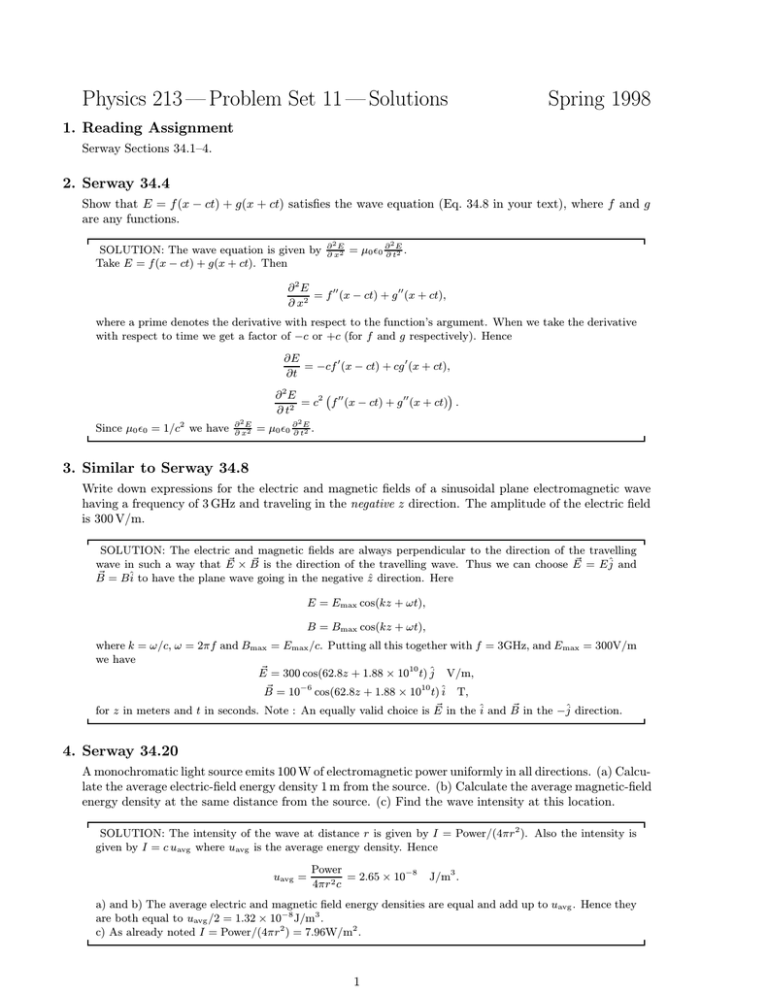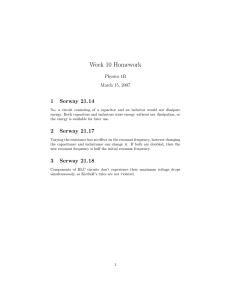Physics 213 — Problem Set 11 — Solutions Spring 1998
advertisement

Physics 213 — Problem Set 11 — Solutions Spring 1998 1. Reading Assignment Serway Sections 34.1–4. 2. Serway 34.4 Show that E = f (x − ct) + g(x + ct) satisfies the wave equation (Eq. 34.8 in your text), where f and g are any functions. SOLUTION: The wave equation is given by Take E = f (x − ct) + g(x + ct). Then ∂2 E ∂ x2 2 = µ0 0 ∂∂ tE2 . ∂2E = f 00 (x − ct) + g 00 (x + ct), ∂ x2 where a prime denotes the derivative with respect to the function’s argument. When we take the derivative with respect to time we get a factor of −c or +c (for f and g respectively). Hence ∂E = −cf 0 (x − ct) + cg 0 (x + ct), ∂t ∂2E = c2 f 00 (x − ct) + g 00 (x + ct) . 2 ∂t Since µ0 0 = 1/c2 we have ∂2E ∂ x2 2 = µ0 0 ∂∂ tE2 . 3. Similar to Serway 34.8 Write down expressions for the electric and magnetic fields of a sinusoidal plane electromagnetic wave having a frequency of 3 GHz and traveling in the negative z direction. The amplitude of the electric field is 300 V/m. SOLUTION: The electric and magnetic fields are always perpendicular to the direction of the travelling ~ ×B ~ is the direction of the travelling wave. Thus we can choose E ~ = E ĵ and wave in such a way that E ~ = B î to have the plane wave going in the negative ẑ direction. Here B E = Emax cos(kz + ωt), B = Bmax cos(kz + ωt), where k = ω/c, ω = 2πf and Bmax = Emax /c. Putting all this together with f = 3GHz, and Emax = 300V/m we have ~ = 300 cos(62.8z + 1.88 × 1010 t) ĵ V/m, E ~ = 10−6 cos(62.8z + 1.88 × 1010 t) î T, B ~ in the î and B ~ in the −ĵ direction. for z in meters and t in seconds. Note : An equally valid choice is E 4. Serway 34.20 A monochromatic light source emits 100 W of electromagnetic power uniformly in all directions. (a) Calculate the average electric-field energy density 1 m from the source. (b) Calculate the average magnetic-field energy density at the same distance from the source. (c) Find the wave intensity at this location. SOLUTION: The intensity of the wave at distance r is given by I = Power/(4πr2 ). Also the intensity is given by I = c uavg where uavg is the average energy density. Hence uavg = Power = 2.65 × 10−8 4πr2 c J/m3 . a) and b) The average electric and magnetic field energy densities are equal and add up to uavg . Hence they are both equal to uavg /2 = 1.32 × 10−8 J/m3 . c) As already noted I = Power/(4πr2 ) = 7.96W/m2 . 1 5. Serway 34.30A Lasers have been used to suspend spherical glass beads in the Earth’s gravitational field. (a) If a bead has a mass m and a density ρ, determine the radiation intensity needed to support the bead. (b) If the beam has a radius r, what is the power required for this laser? SOLUTION: a)We assume the glass bead is perfectly reflecting. The pressure P is given by P = 2I/c, where I is the radiation intensity. The force exerted by the radiation must counteract mg, the weight of the bead. Hence P A = mg, where A = πr2 is the cross-section of the bead, and r is the radius. We can find r from 1 m = ρ 34 πr3 , so r = (3m/4πρ) 3 . Putting this all together, I= Pc cmg cmg = = 2 2πr2 2π 4πρ 3m 23 = 2 9π 1/3 cgm1/3 ρ2/3 . b)If the beam has a radius R (this is not necessarily the same as r in part a), then the power needed to produce an intensity I is Power = I · area = IπR = 2 2π 2 9 1/3 R2 cgm1/3 ρ2/3 . 6. Serway 34.46 A microwave source produces pulses of 20 GHz radiation, with each pulse lasting 1 ns. A parabolic reflector (R = 6 cm) is used to focus these into a parallel beam of radiation (ie, plane waves), as in Figure P34.46 of your text. The average power during each pulse is 25 kW. (a) What is the wavelength of these microwaves? (b) What is the total energy contained in each pulse? (c) Compute the average energy density inside each pulse. (d) Determine the amplitude of the electric and magnetic fields in these microwaves. (e) If this pulsed beam strikes an absorbing surface, compute the force exerted on the surface during the 1 ns duration of each pulse. SOLUTION: a)The wavelength is λ = c/f = 1.5 × 10−2 m. b)The energy contained in a pulse is ∆U = Power · T = 25 × 10−6 J. c)We can find the intensity I from I = Power/πR2 , and then the average energy density is uavg = I/c = Power/πR2 c = 7.4 × 10−3 J/m3 during the pulse. 2 2 /2 = Bmax /(2µ0 ), giving Emax = 4.1 × 104 V/m, and Bmax = 1.4 × 10−4 T. d)uavg = 0 Emax e)The beam has a constant cross-section πR2 . The pressure on an absorbing surface (no reflection) is P = I/c = Power/πR2 c, hence the force is F = P πR2 = Power/c = 8.3 × 10−5 N, during the pulse. 7. Serway 34.52 A possible means of space flight is to place a perfectly reflecting aluminized sheet into Earth’s orbit and use the light from the Sun to push this solar sail. Suppose a sail of area 6 × 104 m2 and mass 6000 kg is placed in orbit facing the Sun. (a) What force is exerted on the sail? (b) What is the sail’s acceleration? (c) How long does it take the sail to reach the Moon, 3.84 × 108 m away? Ignore all gravitational effects, assume that the acceleration calculated in part (b) remains constant, and assume a solar intensity of 1380 W/m2 . SOLUTION: a)The force exerted on the sail is F =pressure×area=2IA/c = 0.55 N. b)The accelaration is a = F/m = 9.2 × 10−5 m/s2 . c)The time it takes to reach the moon is t = p 2d/a = 2.9 × 106 s ≈ 34 days. 8. Practice Problems – Don’t Hand In In Serway Chapt. 34: 9, 11, 13, 23, 27, 45, 53. 2
